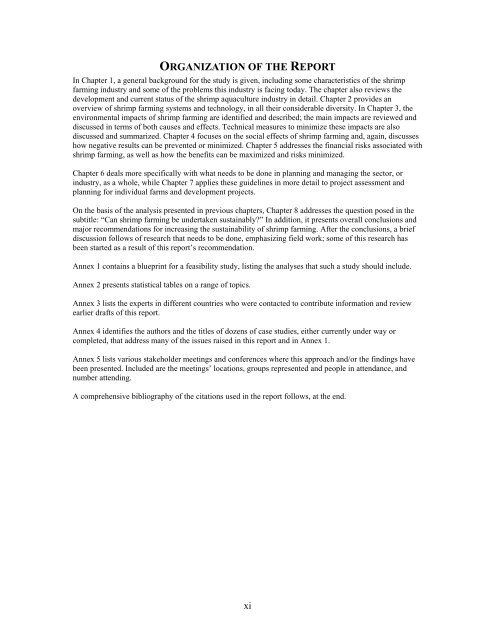Shrimp Farming and the Environment - Library
Shrimp Farming and the Environment - Library
Shrimp Farming and the Environment - Library
Create successful ePaper yourself
Turn your PDF publications into a flip-book with our unique Google optimized e-Paper software.
ORGANIZATION OF THE REPORTIn Chapter 1, a general background for <strong>the</strong> study is given, including some characteristics of <strong>the</strong> shrimpfarming industry <strong>and</strong> some of <strong>the</strong> problems this industry is facing today. The chapter also reviews <strong>the</strong>development <strong>and</strong> current status of <strong>the</strong> shrimp aquaculture industry in detail. Chapter 2 provides anoverview of shrimp farming systems <strong>and</strong> technology, in all <strong>the</strong>ir considerable diversity. In Chapter 3, <strong>the</strong>environmental impacts of shrimp farming are identified <strong>and</strong> described; <strong>the</strong> main impacts are reviewed <strong>and</strong>discussed in terms of both causes <strong>and</strong> effects. Technical measures to minimize <strong>the</strong>se impacts are alsodiscussed <strong>and</strong> summarized. Chapter 4 focuses on <strong>the</strong> social effects of shrimp farming <strong>and</strong>, again, discusseshow negative results can be prevented or minimized. Chapter 5 addresses <strong>the</strong> financial risks associated withshrimp farming, as well as how <strong>the</strong> benefits can be maximized <strong>and</strong> risks minimized.Chapter 6 deals more specifically with what needs to be done in planning <strong>and</strong> managing <strong>the</strong> sector, orindustry, as a whole, while Chapter 7 applies <strong>the</strong>se guidelines in more detail to project assessment <strong>and</strong>planning for individual farms <strong>and</strong> development projects.On <strong>the</strong> basis of <strong>the</strong> analysis presented in previous chapters, Chapter 8 addresses <strong>the</strong> question posed in <strong>the</strong>subtitle: “Can shrimp farming be undertaken sustainably?” In addition, it presents overall conclusions <strong>and</strong>major recommendations for increasing <strong>the</strong> sustainability of shrimp farming. After <strong>the</strong> conclusions, a briefdiscussion follows of research that needs to be done, emphasizing field work; some of this research hasbeen started as a result of this report’s recommendation.Annex 1 contains a blueprint for a feasibility study, listing <strong>the</strong> analyses that such a study should include.Annex 2 presents statistical tables on a range of topics.Annex 3 lists <strong>the</strong> experts in different countries who were contacted to contribute information <strong>and</strong> reviewearlier drafts of this report.Annex 4 identifies <strong>the</strong> authors <strong>and</strong> <strong>the</strong> titles of dozens of case studies, ei<strong>the</strong>r currently under way orcompleted, that address many of <strong>the</strong> issues raised in this report <strong>and</strong> in Annex 1.Annex 5 lists various stakeholder meetings <strong>and</strong> conferences where this approach <strong>and</strong>/or <strong>the</strong> findings havebeen presented. Included are <strong>the</strong> meetings’ locations, groups represented <strong>and</strong> people in attendance, <strong>and</strong>number attending.A comprehensive bibliography of <strong>the</strong> citations used in <strong>the</strong> report follows, at <strong>the</strong> end.xi
















